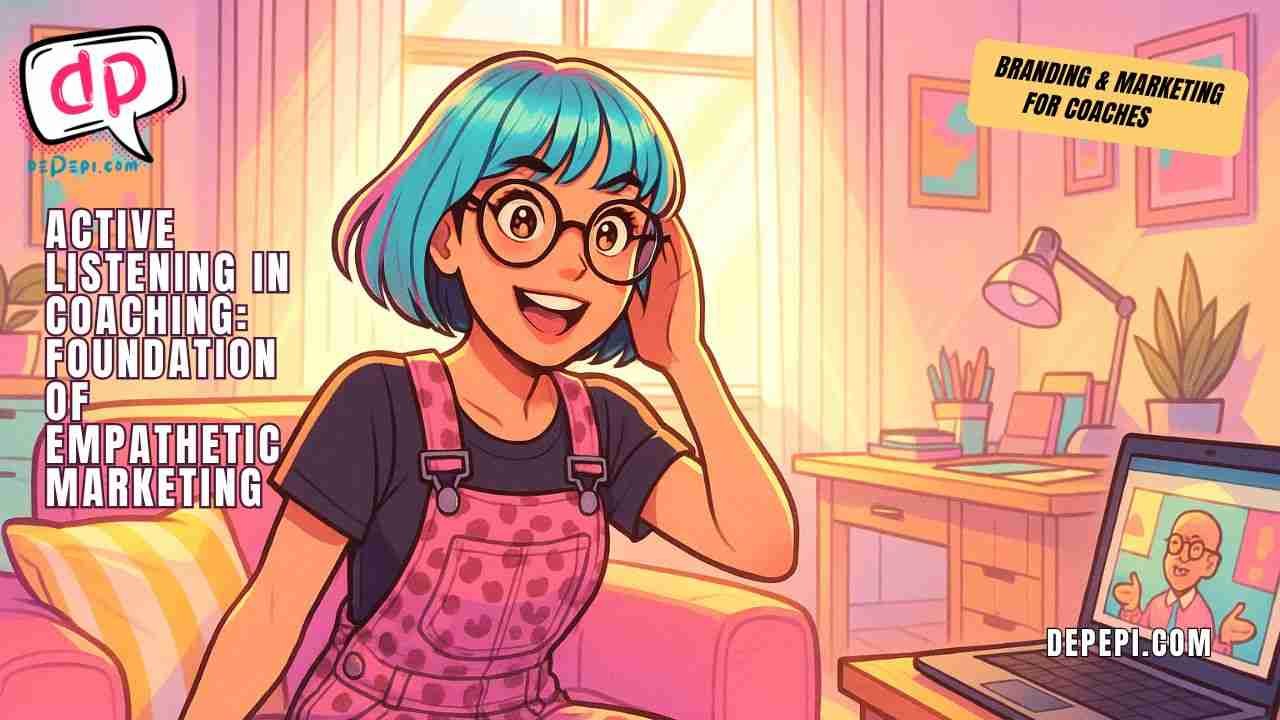Active Listening in Coaching: Foundation of Empathetic Marketing

You’re already an expert listener. So why does your marketing sound like everyone else’s? Active listening in your practice is one of the things you do, yet… You get crickets.
“Pepi, I don’t understand it. My clients always tell me I really ‘get them.’ They say I understand their struggles better than anyone. But when I post on social media or write emails, I get crickets. What am I doing wrong?”
The answer is both profound and straightforward: You’re not using your listening superpowers for marketing. You’re not using “empathetic marketing”.
You already know how to listen deeply. You do it every single coaching session. You hear the emotion behind their words, catch what they’re not saying, and notice patterns across clients. You’re a listening expert.
But then you sit down to create marketing content and suddenly… You forget everything you’ve learned about your clients.
This disconnect is costing you clients, and it’s time to bridge the gap.
The Great Translation Gap: Active Listening in Empathetic Marketing
Here’s what’s really happening in coaching businesses everywhere:
In Your Coaching Sessions
- You listen for emotional subtext
- You catch limiting beliefs in real-time
- You notice the exact words clients use to describe their pain
- You understand their deeper fears and desires
- You see patterns across multiple clients
In Your Marketing
- You default to generic “I help busy professionals” language
- You use industry jargon instead of client language
- You focus on features instead of emotional transformation
- You sound exactly like every other coach in your space
The result?
Your ideal clients scroll past your content because it doesn’t sound like someone who truly understands their experience, even though you absolutely do.
How to Translate it into Empathetic Marketing?
Let’s acknowledge what you’re already brilliant at:
You Listen for Emotion Behind Words
When a client says, “I need better work-life balance,” you immediately hear the deeper story. The guilt about missing bedtime stories. The exhaustion from trying to be perfect everywhere. The fear of failing the people who matter most.
But in your marketing, you write: “Struggling with work-life balance? I can help!”
Instead, you could write: “For the mom lying awake, wondering if you’re failing everyone who matters most…”
You Hear What’s Not Being Said
You notice when clients deflect certain topics, change the subject quickly, or get emotional about seemingly small things. You understand that the pause before they answer reveals as much as their actual words.
But in your marketing, you only address surface-level problems.
Instead, you could speak to: The fears they’re afraid to voice, the shame they carry, the dreams they’ve stopped admitting they want.
You Notice Patterns Across Clients
You’ve heard five different clients use the phrase “wearing a mask at work.” You’ve noticed that Sunday night anxiety comes up in session after session. You see the same limiting beliefs showing up in different people.
However, in your marketing, you create generic content that could be applied to anyone.
Instead, you could create laser-focused content that speaks to these specific patterns you’ve identified.
The Marketing Goldmine Sitting in Your Session Notes
Every client conversation contains marketing insights that most coaches ignore entirely:
The Exact Language They Use
Your clients don’t say they’re “experiencing suboptimal performance metrics.” They say they feel “scattered,” “like a fraud,” or “stuck in quicksand.”
Marketing Translation
Use their exact words in your content. When someone sees their own language reflected back, they immediately think, “This person gets me.”
The Metaphors That Capture Their Experience
Pay attention to how clients describe their situations:
- “I feel like I’m drowning.”
- “It’s like wearing someone else’s clothes.”
- “I’m running on a hamster wheel.”
- “I’m playing a role that doesn’t fit.”
Marketing Translation
These metaphors become incredibly powerful headlines and content hooks because they capture complex emotional experiences in relatable terms.
The Timing of Their Pain
You know exactly when your clients struggle most:
- Sunday night anxiety about the week ahead
- 3 AM worry sessions about whether they’re cut out for this
- The moment they compare themselves to others on LinkedIn
- Walking into meetings feeling like an impostor
Marketing Translation
Create content that speaks to these specific moments. “For everyone lying awake at 3 AM wondering if you’re qualified for the job you already have…”
The Ripple Effects They Fear Most
Your clients aren’t just worried about the surface problem. They’re terrified of:
- Disappointing their families
- Being exposed as a fraud
- Missing their children’s childhood
- Living with regret about dreams they never pursued
Marketing Translation
Address these deeper fears in your content. Show them what becomes possible when they address the root issue.
The Active Listening to Marketing Translation Framework
Here’s how to systematically transform your listening insights into marketing gold:
Step 1: The Session Notes Audit
Go through your recent client sessions and look for:
- Repeated phrases or words
- Emotional language and metaphors
- Common fears or concerns
- Patterns in how they describe their ideal outcomes
- The exact words they use (not your interpretation of what they mean)
Step 2: The Language Library
Create a document with:
- Client Phrases: The exact words they use
- Emotional Themes: The feelings that come up repeatedly
- Metaphors: How they describe their experiences
- Timing Triggers: When they feel their pain most acutely
- Deeper Fears: What they’re really afraid will happen
Step 3: The Marketing Translation
Transform your insights into marketing messages:
- From session: “I feel like I’m wearing a costume that doesn’t fit.” To marketing: “Tired of wearing a leadership costume that doesn’t feel like you?”
- From session: “Every Sunday night, I get this pit in my stomach.” To marketing: “Sunday Night Anxiety: What Your Dread Is Really Telling You”
- From session: “I’m scattered in every direction.” To marketing: “From Scattered to Centered: A Guide for High-Achievers Who Feel Pulled Apart”
Why This Approach Transforms Everything
When you bridge the gap between listening and marketing:
- Your content becomes magnetic: People immediately recognize their own experience in your words.
- Discovery calls feel different: Prospects already feel understood before they even book a call.
- Sales resistance disappears: When people feel genuinely seen, they don’t feel “sold to”—they feel helped.
- You stand out authentically: Your marketing sounds distinct because it’s grounded in real human experiences, not generic industry language.
- Client retention improves: When your marketing accurately reflects your understanding, you attract clients who are perfectly aligned with your business.
The Common Mistakes That Kill This Approach
Translating Too Literally
Don’t just copy and paste client language. Translate the emotional essence while maintaining professional boundaries and client confidentiality.
Forgetting to Document
If you don’t capture insights as they happen, you’ll forget the nuances that make your marketing powerful.
Using Only One Client’s Language
Look for patterns across multiple clients. One person’s experience might be unique; five people’s similar experience is a market segment.
Staying Too Surface-Level
Don’t just listen for problems; listen for the emotional context that makes those problems meaningful.
Strategic Integration
Your listening skills are incredibly valuable, but they’re just one piece of building a thriving coaching practice. The real magic happens when you integrate these insights into a comprehensive marketing strategy that consistently attracts your ideal clients.
This is exactly what I teach in my Branding and Marketing for Coaches course.
Branding and Marketing for Coaches (Life, Health, Wellness)
Your Listening-to-Marketing Action Plan
This Week
- Review your last 10 client sessions for language patterns
- Document the exact phrases clients use repeatedly
- Identify 3 emotional themes that come up consistently
Next Week
- Create 5 pieces of content using the client’s language directly
- Test these messages and compare engagement to your usual content
- Notice how differently people respond when you use their actual words
Ongoing
- Keep a “Client Language Library” document
- Add insights after every session
- Translate these insights into marketing content monthly
The Revolution Is in Translation
You don’t need to become a better listener—you’re already excellent at that. You need to become better at translating your listening into marketing that connects.
Your clients are literally telling you how to market to them in every session. They’re giving you the exact words, metaphors, and emotional context that will make your marketing magnetic.
The coaches who thrive aren’t better listeners than you. They’re better translators.
Your ideal clients are tired of generic marketing that doesn’t accurately reflect their unique experiences. They’re looking for someone who truly gets them, and you already do.
Now it’s time to let your marketing reflect that understanding.
What client phrase have you heard repeatedly but never used in your marketing?






